Article and all photos by Joe Mock, BaseballParks.com
All rights reserved
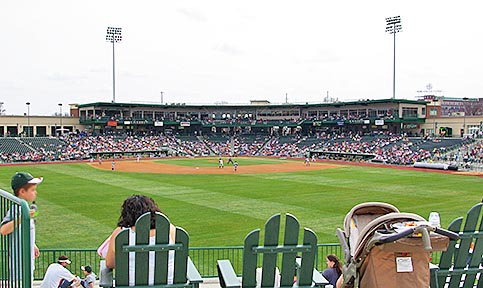 |
First, if you don’t understand that Johnny Appleseed is a local folk hero in the Fort Wayne area, then much of the great symbolism surrounding the city’s baseball team and new ballpark will be lost on you. The etched glass. The souvenirs in the retail store. The food items at the Apple Cart kiosk. Even the team’s nickname.
| Ballpark Stats |
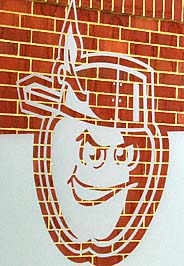 |
| Team: The Fort Wayne TinCaps of the Class A Midwest League |
| First game: April 16, 2009 — a 7-0 win over Dayton |
| Capacity: 8,100 |
| Architect: Populous (formerly HOK) |
| Construction: Weigand |
| Price: $30.6 million |
| Home dugout: First base side |
| Field points: northeast |
| Playing surface: bluegrass |
| Betcha didn’t know: J. Chapman’s, the party deck, is also named for Johnny Appleseed, whose real name was John Chapman |
As has become customary when a team moves into a new ballpark, the Fort Wayne Wizards of the Midwest League decided to switch to a different nickname for 2009. They came up with the name TinCaps, because Johnny Appleseed allegedly wore a tin cooking pot on his head as he traveled about cultivating apple trees.
John Chapman, Mr. Appleseed’s actual name, was a real person, not a myth. He was a conservationist and itinerate preacher who traveled around the Midwest without wearing shoes in the first half of the 19th Century. And, yes, he planted many apple orchards. He visited Fort Wayne often in the latter part of his life, and in fact died there in 1845. There’s little doubt that he is buried there as well, but the exact spot of his grave has been debated by locals.
Wikipedia points out, by the way, he probably did not wear a tin cap — but let’s not allow the facts to get in the way of a good baseball team nickname! And to be fair, many historians dispute Wikipedia’s naysayer proclamation that he never wore cookware on his head.
Regardless, today Fort Wayne’s Swinney Park is home to the Johnny Appleseed Memorial, and a separate park in town is home to the Johnny Appleseed Festival each fall.
Decidedly younger than the Johnny Appleseed legend is Fort Wayne’s Memorial Stadium. It was built in 1993, but after only 14 years of life, the city decided to replace it. It was a ballpark that was “charmless, featureless and amenity-less” said Jason Freier, the CEO of Hardball Capital, which owns the TinCaps. Other than that, it was quite a facility.
The fate of the sterile ballpark, which was located only four miles away from downtown (but when you look at its surroundings, it seems more like a thousand miles away), was sealed in 2007. That’s when it was decided that a shiny new baseball facility would be the anchor for a significant urban-renewal project downtown known as Harrison Square.
The cost to construct the ballpark itself was a remarkably low $30.6 million. “I have to think we spent as much time planning and value engineering the ballpark as anyone has for a minor league facility,” said Freier. Because the park was built by a combination of team money and funding from the city, it was “critical for us to be careful stewards of the public funds. As you know, a good relationship with the local government and a feeling in the general public that we are good partners (and are) community-minded is vital to the long term success of the ball team.”
Freier actually lives in Georgia and has attended games in the new Gwinnett Stadium, a $59-million Triple-A facility that also opened this year. He and his investors all agreed “that if you were told that one of these parks cost about $60 million and the other about $30 (million), they would have guessed it was the other way around.”
Me, too.
So what does Parkview Field have to offer the baseball patrons of Fort Wayne? Let’s take a closer look at its surroundings, the park’s exterior, its interior design and the amenities fans will find there.
The Setting
Once Harrison Square is completed, it will be an impressive place indeed. There will be a new hotel beyond the park’s center field, and condos and retail will be built beyond left field. As the ballpark opened, construction on these other structures was underway, so it won’t be like St. Louis’ “ballpark village” that remained an undeveloped lot for quite awhile after new Busch Stadium opened.
Even before the rest of the extensive urban-renewal project is done, the ballpark is in good company. Its location on the southwest corner of downtown allows fans to view the city’s skyline, including City Hall, the tall One Summit Square, various church steeples and the historic Indiana Hotel. The latter is currently being renovated, and one day it will connect to the new hotel that is being constructed beyond the ballpark’s center field.
  |
The huge parking garage just beyond right-center field serves a triple purpose: 7,000 square feet of meeting space on the ground level; the Treetops roof-top seating section above that; and, well, parking your car. If you do park here, don’t bother going up to the garage’s top level expecting to catch a great view of the inside of the ballpark. Whether intentional or not (probably not), the wall was built high enough (above right) that you can’t look down at the game for free.
By the way, the architects for the garage and the related Treetops and meeting-space areas were from Schenkel Schultz, a local firm.
So there is sufficient parking surrounding the ballpark, and once the commercial buildings are constructed, there should be even more eating, drinking and shopping opportunities. All in all, I am quite impressed with the scope and specifics of the Harrison Square project — and perhaps most impressive (compared to all of the other new ballparks this year) is that all of its buildings are actually being constructed!
The Exterior
Parkview Field’s exterior is simply gorgeous. As is the case at Columbus’ new Huntington Park, the exterior in Fort Wayne was designed by architects who really know what they’re doing with a baseball park.
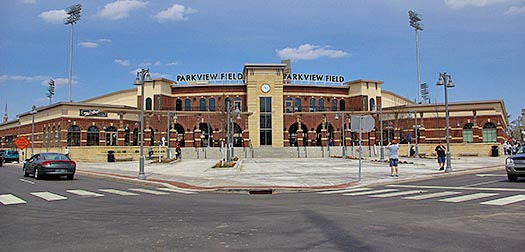 |
From the stunning, classic entry behind home plate (above) to the see-through iron fence (below left) to the stately gates in center field, this is as pretty as the outside of a ballpark can get.
At first glance, you would assume that the exterior is constructed using brick and pre-cast concrete. If you look more closely, you’ll see that the lighter-colored material is actually sandstone — sienna mocha buff sandstone, to be exact. All 260 tons of it came from a quarry in Bedford, Indiana. Again, you wonder how the modest pricetag of $30.6 million permitted the use of such attractive materials.
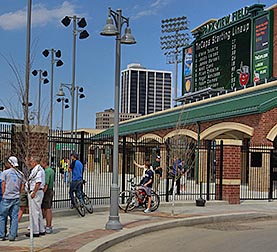 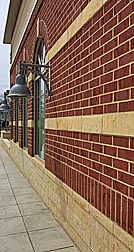 |
“Aesthetically, we wanted the ballpark itself to fit in with the numerous great old buildings that exist in downtown Fort Wayne,” said Freier. He noted that the brick-and-sandstone combination was used in other historic structures in the area, particularly the old firehouse that is now a firefighters museum a couple of blocks north of Parkview Field.
And look more closely at the main entry plaza. It is spacious, multi-leveled and has a judicious use of landscaping. In the grand style of classic museums and other public buildings, the plaza conveys a strong sense that you are about to enter an important facility. We’ll talk more about the arches in our next section, but for now, notice the traditional capstones and the way the entry arches are mirrored in the shape of the windows on the upper level.
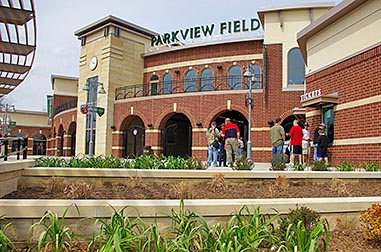 |
The other main entryway is along busy Jefferson Boulevard. Dubbed the North Gate (below), it ushers fans into the center-field plaza area. The brick columns beckon you to climb the grand steps and see what all of the fuss is about.
Once the other buildings are completed — particularly the three-story retail/condo building that will be just to the right of this entryway — these gates will have a different feel. Frankly, I think they’ll work both before and after the condos are in place. “Once the project (Harrison Square) is complete,” Freier told me, “we also want the stadium to fit into … and relate to the other buildings as if all have been there for a century.”
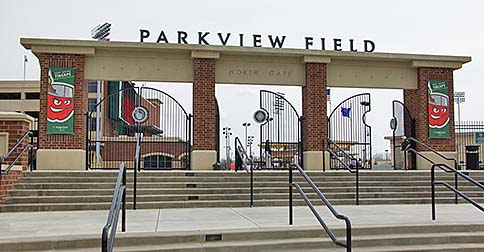 |
The Design
You know, with Populous — the new name for HOK — being heavily involved in the two new Major League parks opening in New York this year, as well as the very ambitious spring-training park in Goodyear (not to mention Target Field that will open in Minneapolis next year), I was fearful that a ballpark in the low-A Midwest League might not get the best and brightest designers at Populous. My fears were unfounded.
In fact, Populous associate principal Martin DiNitto put it this way: “Projects like Parkview Field are at the heart and soul of our practice.” The effort they put into the park’s design certainly attest to this fact.
Indeed, the architectural work here is first-rate. Not only does it pass the “first glance” test with flying colors, it also blows you away when you start doing a thorough analysis of the finer points of the design — especially as “themes” are carried out in different parts of the facility.
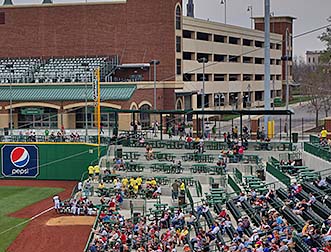 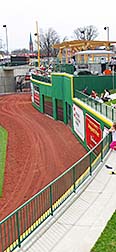 |
For one thing, the convex-shaped canopy over the picnic area in the right-field corner (and the shape of the tiers that hold those picnic tables nearest the foul pole — left photo above) perfectly complements the convex shape of the home-run porch area that protrudes into left field (upper right). This convex shape isn’t nearly as overdone as the one in center field in Albuquerque. Anyway, shapes that are rounded are repeated beautifully throughout the entire facility.
The aforementioned arches, borrowing from the beautiful firehouse nearby, are found in strategic locations around Parkview Field. You see a version of them along the front edge of the first story of the parking-garage structure (lower left) and in the entryways behind home plate (lower right). You’ll also see them in all of the second-story windows, and you’ll enjoy the sweeping, curved coverings in the promenade in the entry plaza.
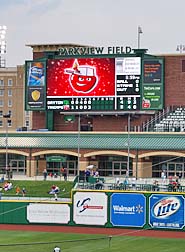  |
I like that the seating bowl wasn’t chopped up to create an “us versus them” area of extra-expensive seats right behind the backstop (below left). The sections in the infield, called All Star seats, aren’t separated from other sections. And they have a perfect pitch and are nice and close to the field. Well done.
Perhaps my favorite elements of the design are found in center and left field. Here you’ll find ample use of (surprise!) wood, as the Center Field Grill (below right) operates as a stand-alone kiosk, using the “tiki bar” approach so popular in spring training parks. Here you can see straight through to the field while you’re ordering your food, and the positively gorgeous structure is made of brick at the base and trellised wood above.
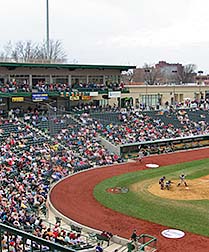 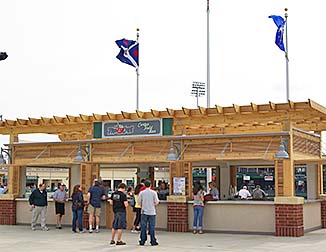 |
The trellis look continues in a series of wooden structures (below left) at the rear of the Home Run Porch seats in left field. I like the theme a lot. I’m also really partial to those Porch seats, because not only do they bow into the field, they also come complete with countertops. Freier told me that his “pet peeve” is not having anywhere to put your food and drink while watching the ballgame. That is solved in this area (below right).
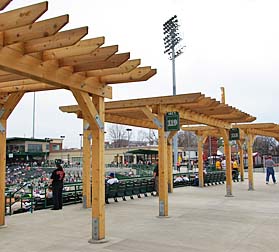 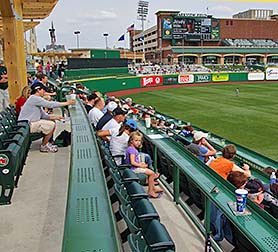 |
Nearby in the left-field corner are seats called Field Boxes (below left), which aren’t anything like “box seats” as you think of them in the modern sense. No, this is the old style of boxes, like in theaters and ballparks of many decades ago. Here you have railings that separate your space — a table and four tall chairs — from your neighbors. The boxes closest to the field are virtually in the visitors’ bullpen. Best of all, there’s waitservice here.
The whole area in center and left field is a real winner, and is unlike most new parks. Freier pointed out that the designers felt that “this would be an attractive area for young professionals and college students who are looking for a social night out at the ballpark.” There are tables and chairs out on the concourse, and you’re close to the berm if you want to keep an eye on the action on the field. What’s the price to be a part of this mix-and-mingle scene? Only $5, the cost of a general admission ticket. That’s “less than the cover charge in many bars,” Freier noted.
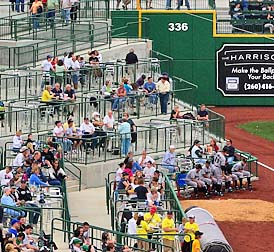 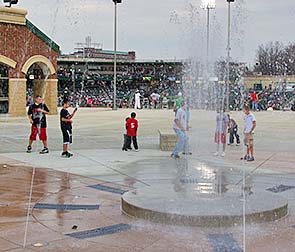 |
While the grand architectural elements are found in the main structure in the infield and in the parking structure in right field, I bet one of the most popular areas in Parkview Field will end up being the concourse in left and center field. Young adults can socialize and youngsters can run through the fountains at the far end of the concourse (above right). These fountains are adjacent to a small amphitheater where bands can play before or after games.
Frankly, this is the outfield concourse that the new Triple-A park in Gwinnett County should’ve had.